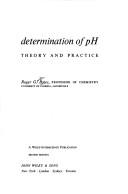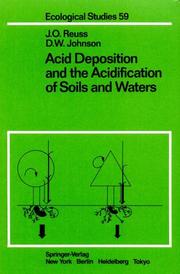| Listing 1 - 9 of 9 |
Sort by
|
Book
ISBN: 0387184856 3540184856 3642730957 3642730930 9780387184852 Year: 1988 Publisher: Berlin Springer
Abstract | Keywords | Export | Availability | Bookmark
 Loading...
Loading...Choose an application
- Reference Manager
- EndNote
- RefWorks (Direct export to RefWorks)
Book
ISBN: 2130358675 9782130358671 Year: 1979 Volume: 1248 Publisher: Paris : PUF - Presses Universitaires de France,
Abstract | Keywords | Export | Availability | Bookmark
 Loading...
Loading...Choose an application
- Reference Manager
- EndNote
- RefWorks (Direct export to RefWorks)
Book
Year: 2005 Publisher: Bruxelles: UCL,
Abstract | Keywords | Export | Availability | Bookmark
 Loading...
Loading...Choose an application
- Reference Manager
- EndNote
- RefWorks (Direct export to RefWorks)
Staphylococcus aureus is able to survive and multiply in several environments, and, in particular, in acidic media such as abscesses, skin or some intracellular compartments (phagolysosomes). For this reason, it is considered as an intracellular opportunistic bacterium. The intracellular persistence of S. aureus might be determinant for the recurrent character of infections as well as for the difficulty of eradication with antibiotics. Current treatment for staphylococcal infections consists in the administration of a isoxazolylpenicillin resistant to penicillinase (such as oxacilline), in association with an aminoglycoside (gentamicin) in case of severe infections.
In this work, we have compared the activity of oxacillin and gentamicin against extracellular and intracellular (in a model of infected macrophages) form of S. aureus by examining, on the one hand, their pharmacodynamic properties ad, on the other hand, the influence of acidic pH on their activity in both environments.
In broth (cell-free system), pharmacodynamic studies showed that antibiotics display a concentration-dependent bactericidal activity (sigmoidal curve ; static effect at ~ 2x CMI and maximal effect, ~ 4.5 log decrease from the initial inoculum) and that the effect of time is more marked on oxacilline than gentamicin (maximal effect achieved after 24h rather than 6h). The study of the influence of the pH on this activity highlighted that the dose-effect relationship are not modified in their sigmoidal shape upon acidification of the medium, but that the activity of gentamicin decreased at low pH (static effect obtained for concentrations 8x higher when pH decreases of one unit) while that of oxaxillin increases at low pH (static effect obtained for concentrations 2.5x lower when pH decreases of one unit).
In a model on intracellular infection, both antibiotics also showed a concentration-dependent activity, the intensity of which being however reduced (sigmoidal curves; static effect at ~ 3x CMI and maximal effect, ~ 0.8 log decrease from the initial inoculum). A partial neutralization of lysosomal pH by addiction of ammonium chloride increased the intracellular activity of gentamicin in cells incubated with high concentrations of antibiotic. Ammonium chloride also increases the activity of oxacillin, but only when the antibiotic is used at low concentrations.
On these bases, we can conclude that the activity of gentamicin against S. aureus is compromised in acidic environments (including intracellular infections), while the activity of oxacillin is improved by acidity extracellularly, but not intracellularly. The reasons for this divergence need to be explored. In addition, our pharmacodynamic studies show that the activity of both antibiotics can be optimised, whatever the pH of the infected site, by using high concentrations of antibiotic (within the limit of their safety) and, for oxacilline, by prolonging also the time of contact with bacteria Staphylococcus aureus est capable de survivre et de se multiplier dans des environnements divers, et, en particulier, dans les milieux acides., tels que les abcès ou la peau, ou encore certains compartiments intracellulaires (phagolysosomes). A ce titre, il peut être considéré comme une bactérie intracellulaire opportuniste. La persistance intracellulaire de S. aureus pourrait être un facteur déterminant dans la récurrence de certaines infections, mais aussi dans la difficulté d’éradiquer les bactéries à l’aide d’antibiotiques. Le traitement actuel des infections à S. aureus consiste en l’administration d’une isoxazolylpénicilline résistantes aux pénicillinases (oxacilline, par exemple), à laquelle on peut associer un aminoglycoside (gentamicine) en cas d’infections sévères.
Dans le cadre de ce mémoire, nous avons comparé l’activité de l’oxacilline et de la gentamicine vis-à-vis des formes extracellulaires et intracellulaires (modèle de macrophages infectés) de S. aureus, en examinant d’une part leurs propriétés pharmacodynamiques, et d’autre part, l’influence du pH acide sur leur activité dans ces deux environnements.
En milieu extracellulaire, les études pharmacodynamiques montrent que les deux antibiotiques présentent une activité bactéricide concentration-dépendant (courbe d’allure sigmoïde ; effet statique obtenu à environ 2x la CMI ; effet maximal, ~ 4.5 log de réduction par rapport à l’inoculum initial), et que l’effet du temps est plus marqué sur l’activité de l’oxacilline que sur celle de la gentamicine (effet maximal atteint après 24h plutôt que 6h ). L’étude de l’influence du pH sur cette activité a mis en évidence que les relations dose-effet ne sont pas modifiées dans leur allure par une acidification du milieu, mais que le gentamicine est moins active ) pH acide (effet statique obtenu pour une concentration 5 fois plus élevée lorsque le pH baisse d’une unité) tandis que l’oxacilline est plus active à pH acide (effet statique obtenue pour une concentration 2.5 fois plus faible lorsque le pH diminue d’une unité). En milieu intracellulaire, les deux antibiotiques montrent également une activité concentration-dépendante, mais dont l’intensité est réduite (courbes sigmoïdes ; effet statique obtenu à environ 3x la CMI ; effet maximal, ~ 0.8 log de réduction par rapport à l’inoculum initial). Une neutralisation partielle du pH des lysosomes par l’addition de chlorure d’ammonium entraîne une augmentation l’activité intracellulaire de la gentamicine lorsque les cellules sont incubées avec des concentrations élevées en antibiotique. La présence de chlorure d’ammonium augmente également l’activité de l’oxacilline, mais uniquement lorsque celle-ci est utilisée à faible concentration.
Sur ces bases, nous pouvons conclure que l’activité de la gentamicine vis-à-vis de S. aureus est compromise dans des environnements acides (y compris dans des infections intracellulaires). L’activité de l’oxacilline, quant à elle, est améliorée par l’acidité en milieu extracellulaire, mais pas en milieu intracellulaire. Les raisons de cette divergence restent à explorer. Par ailleurs, nos étude pharmacodynamiques démontrent que l’on peut optimiser l’activité des deux antibiotiques, quel que soit le pH du foyer infecté, en utilisant des concentrations élevées en antibiotique (dans la limite de leur sécurité d’emploi), et , pour l’oxacilline, en prolongeant également le temps de contact avec les bactéries
Hydrogen-Ion Concentration --- Staphylococcus aureus --- Anti-Bacterial Agents

ISBN: 0471056472 9780471056478 Year: 1973 Publisher: New York, NY ; London ; Sydney, N.S.W [etc.] : John Wiley,
Abstract | Keywords | Export | Availability | Bookmark
 Loading...
Loading...Choose an application
- Reference Manager
- EndNote
- RefWorks (Direct export to RefWorks)
fysicochemie --- Electrochemistry --- Hydrogen-ion concentration --- Electrochimie --- Measurement --- Hydrogen-Ion Concentration. --- 543.257.1 --- -#WSCH:AAS1 --- #WSCH:AAS3 --- Hydrogen-ion activity --- pH (Chemistry) --- Acidity function --- Chemistry, Physical and theoretical --- Potentiometric analysis. Determination of hydrogen ion concentration. pH value --- Waterstofionenconcentratie --- Waterstofionenconcentratie. --- 543.257.1 Potentiometric analysis. Determination of hydrogen ion concentration. pH value --- Hydrogen-Ion Concentration --- #WSCH:AAS1 --- pH --- Concentration, Hydrogen-Ion --- Concentrations, Hydrogen-Ion --- Hydrogen Ion Concentration --- Hydrogen-Ion Concentrations --- Acid-Base Equilibrium --- Proton-Motive Force --- Hydrogen --- Analysis --- Hydrogen-ion concentration - Measurement --- Acids --- Bases
Book
ISBN: 0471786403 9780471786405 Year: 1973 Publisher: New York : John Wiley & Sons,
Abstract | Keywords | Export | Availability | Bookmark
 Loading...
Loading...Choose an application
- Reference Manager
- EndNote
- RefWorks (Direct export to RefWorks)
Factory and trade waste --- Process control --- Electrochemical analysis --- Hydrogen-ion concentration --- Environmental aspects --- Measurement --- Control of industrial processes --- Industrial process control --- Automatic control --- Manufacturing processes --- Quality control --- Hydrogen --- Pollution --- Analysis, Electrochemical --- Analysis, Electrolytic --- Electroanalysis --- Electrolytic analysis --- Chemistry, Analytic --- Electrochemistry --- Analysis --- Quantitative --- Analytical chemistry --- Factory and trade waste - Environmental aspects --- Hydrogen-ion concentration - Measurement --- Feedback control systems --- Process control. --- Electrochemical analysis. --- Water Pollution. --- Hydrogen-Ion Concentration. --- Industrial Waste. --- Ions --- Déchets industriels. --- Commande de processus. --- Analyse électrochimique. --- Environmental aspects. --- Measurement. --- analysis.
Book
ISBN: 0477066682 9780477066686 Year: 1980 Publisher: Lower hutt New Zeeland Society of Soil Science
Abstract | Keywords | Export | Availability | Bookmark
 Loading...
Loading...Choose an application
- Reference Manager
- EndNote
- RefWorks (Direct export to RefWorks)
Soil acidity --- Soil chemistry --- Soil science --- Soils --- Hydrogen-ion concentration --- Analysis --- #ABIB:altk --- Soil chemistry. --- Soil science. --- Variable charge soils. --- Sols. --- Soils - Analysis
Book
ISBN: 3540507825 3642744443 3642744427 9783540507826 Year: 1991 Publisher: Berlin: Springer,
Abstract | Keywords | Export | Availability | Bookmark
 Loading...
Loading...Choose an application
- Reference Manager
- EndNote
- RefWorks (Direct export to RefWorks)
Soil acidity --- Sol acide --- Acid soils --- Acidification --- Facteur édaphique --- Edaphic factors --- Écosystème --- ecosystems --- Population végétale --- plant population --- Aluminium --- Équilibre acidobasique --- Acid base equilibrium --- #KVIV:BB --- 631.415 --- Soil reaction. Soil acidity and alkalinity. Hydrogen ion concentration in soil (pH value) --- 631.415 Soil reaction. Soil acidity and alkalinity. Hydrogen ion concentration in soil (pH value)

ISBN: 0387962905 3540962905 1461264294 1441985360 9783540962908 9780387962900 Year: 1986 Volume: 59 Publisher: New York, NY ; Berlin ; Heidelberg [etc.] : Springer-Verlag,
Abstract | Keywords | Export | Availability | Bookmark
 Loading...
Loading...Choose an application
- Reference Manager
- EndNote
- RefWorks (Direct export to RefWorks)
Air pollution. Air purification --- Soil pollution. Soil purification --- Water supply. Water treatment. Water pollution --- 631.415 --- Acid deposition --- -Soil acidification --- Acidification --- Acidic deposition --- Deposition, Acid --- Pollutants --- Soil reaction. Soil acidity and alkalinity. Hydrogen ion concentration in soil (pH value) --- Environmental aspects --- 631.415 Soil reaction. Soil acidity and alkalinity. Hydrogen ion concentration in soil (pH value) --- Soil acidification --- Acid deposition - Environmental aspects --- COMPUTERIZED SIMULATION --- FOREST ECOLOGY --- SOLUTIONS (CHIMIE) --- NITROGEN CYCLE --- SULFUR CYCLE --- WATER --- SOILS --- ACIDIFICATION --- ACID PRECIPITATION --- INTERACTIONS
Book

ISBN: 0891188037 9780891188032 Year: 1993 Volume: 32 Publisher: Madison Soil science society of America
Abstract | Keywords | Export | Availability | Bookmark
 Loading...
Loading...Choose an application
- Reference Manager
- EndNote
- RefWorks (Direct export to RefWorks)
Soils --- Pesticides --- Organic compounds --- Pesticide content --- Congresses. --- Organic compound content --- Biodegradation --- 631.414.3 --- 631.415 --- Earth (Soils) --- Mold, Vegetable --- Mould, Vegetable --- Soil --- Vegetable mold --- Agricultural resources --- Plant growing media --- Regolith --- Land capability for agriculture --- Economic poisons --- Agricultural chemicals --- Pests --- Poisons --- Compounds, Organic --- Organic chemicals --- Carbon compounds --- 631.414.3 Absorption. Adsorption --- Absorption. Adsorption --- 631.415 Soil reaction. Soil acidity and alkalinity. Hydrogen ion concentration in soil (pH value) --- Soil reaction. Soil acidity and alkalinity. Hydrogen ion concentration in soil (pH value) --- Biodegradation&delete& --- Congresses --- Organic compound content&delete& --- Pesticide content&delete& --- Control --- Equipment and supplies --- Conferences - Meetings --- Soils - Pesticide content - Congresses. --- Soils - Organic compound content - Congresses. --- Pesticides - Biodegradation - Congresses. --- Organic compounds - Biodegradation - Congresses.
| Listing 1 - 9 of 9 |
Sort by
|

 Search
Search Feedback
Feedback About UniCat
About UniCat  Help
Help News
News